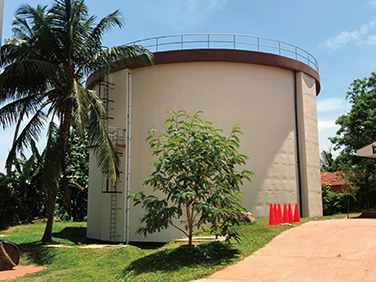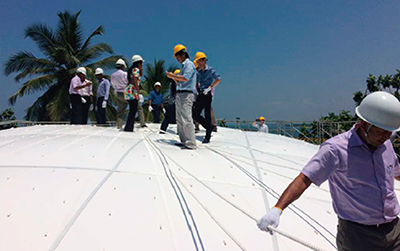Master Techniques from Japan to the World 2
Improving Water-Related Issues in Sri Lanka with Japanese Technology
– Introduction of Space Saving, Low-Cost “PC Tanks” and Safe “Air Dome Engineering”

PC Tank constructed by ABE NIKKO KOGYO Co., Ltd. in Beruwala, in the southwest of Sri Lanka (Photo: ABE NIKKO KOGYO Co., Ltd.)
In Sri Lanka, one of the major challenges is the stable supply of good-quality water to many citizens as the water supply coverage ratio is stuck at less than 50%. However, even in regions where the water supply is available, people’s daily lives remain inconvenient since a lack of water tanks makes it difficult to provide an adequate amount of water stably, and causes frequent “time-restricted water supply,” where water is only supplied at certain times of the day. Thus, there has been a great demand for the construction of additional water tank facilities, in order to ensure stable water supply. Given this situation, as the staff of Sri Lanka’s National Water Supply and Drainage Board (NWSDB) were trying to find a solution to this problem, they became interested in the water supply tank technology called “PC Tanks” made by ABE NIKKO KOGYO Co., Ltd., the headquarters of which is in Gifu Prefecture.
PC is an abbreviation of “Pre-stressed Concrete (concrete that is compressed in advance).” This concrete has the combined qualities of thinness, strength and durability. PC Tanks not only can prevent cracks in the tanks, but also can be built with large capacities even on limited land. Like Japan, Sri Lanka’s land area is so tight that the country must construct large-capacity tanks on restricted areas. Since PC Tanks can be constructed with high water level even on narrow spaces of land, they are perfectly suited to the country. As such, it was decided that ABE NIKKO KOGYO Co., Ltd. would carry out an investigation, starting in September 2013, to determine the usefulness of PC Tanks in Sri Lanka, as a feasibility study funded by the Ministry of Foreign Affairs.
ABE NIKKO KOGYO Co., Ltd. is also constantly improving its PC Tanks, and has other unique technologies, such as “Air Dome Engineering.” With this technology, tanks can be built safely in a short construction period using a certain method where a vinyl chloride film is used to cover the entire upper part of the cylindrical tank, and air pressure is applied from the inside in order to form a dome-shaped temporary roof.

Japanese and Sri Lankan engineers checking the mounting of the Air Dome over the top of a PC Tank (Photo: ABE NIKKO KOGYO Co., Ltd.)
When ABE NIKKO KOGYO Co., Ltd. explained the superiority of this technology to NWSDB executives, they strongly expressed their hopes to construct the PC Tanks in Sri Lanka. Hence, in December 2014, it was decided that the company would construct a PC Tank via Air Dome Engineering, with a storage capacity of 2,000m3 and water level of 10m, two times higher than the level of a regular water supply tank, in the town of Beruwala in the southwest of Sri Lanka, as a pilot project, under JICA’s Verification Survey with Private Sector for Disseminating Japanese Technologies.
However, despite many advantages, most of the Sri Lankan people in charge of design and planning at the time believed that it was not necessary to make efforts to introduce new technology from Japan since there had been no problem with the British technology that the country had been using until then. As such, ABE NIKKO KOGYO Co., Ltd. faced difficulties in getting the Sri Lankan side to understand their technology.
“For this reason, we invited NWSDB engineers from Sri Lanka to Japan and explained the designing method while letting them see the PC Tanks with their own eyes, and by doing so, we succeeded in making them recognize the excellence of the technology. Moreover, after the NWSDB engineers returned to their country, they promoted the brilliance of ABE NIKKO KOGYO’s PC Tanks clearly and precisely to the people who were thinking it was unnecessary to construct water tanks using new technology. I believe such actions taken by the NWSDB engineers also played a big part in the introduction of the product.” says Mr. Shigemasa Katada, Manager of the Container Engineering Department that promoted the project, recalling the situation at that time.
ABE NIKKO KOGYO Co., Ltd. commenced the construction of the PC Tank in 2015. While the company’s engineers demonstrated the improvements from the conventional technology, one by one, to the NWSDB engineers, and accurately explained the advantages of the Japanese construction method, thereby they deepened mutual understandings and made progress on the construction.
“Nevertheless, most of the NWSDB engineers still could not understand the brilliance of PC Tanks without actually seeing the completed product. However, after viewing the finished PC Tank in 2016, they finally adequately understood our technology and its advantages.” tells Mr. Hirokazu Degawa, Manager of the Overseas Operations Department.
After that, the pipework was completed by NWSDB in March 2018. Finally, the entire water station was completed, and it started operation in May of the same year, which allowed water to be stably delivered to 14,650 new households. If we set the average number of people in a household as five based on the current situation in Sri Lanka, it means that over 70,000 people have benefitted from the constructed PC Tanks. This achievement has been highly praised by the Sri Lankan side, and the plans are now underway for the construction of further six PC Tanks.
Mr. Hiroshi Nishio, vice-president of the company mentions, “Experience is very important when conducting projects overseas. Our company has gained a lot of truly valuable experience here in Sri Lanka, which has given us a great deal of confidence. Thanks to this experience, in June 2018, we were able to receive an order for construction of the Mass Rapid Transit (MRT) system in Dhaka, Bangladesh, together with another Japanese company and a local company.”
Mr. Nishio hopes that in the future, they can proactively expand their business into other regions that have numerous demands for infrastructure that can be built using PC tanks, mainly in developing countries, by utilizing the experience accumulated in Sri Lanka.
<< Previous Page Next Page >>
Main Text | Reference Statistics | Stories from the Field | Master Techniques from Japan to the World | ODA Topics
